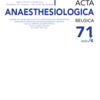Regional anesthesia combined with virtual reality hypnosis for extended orthopedic surgery: two case reports
Virtual Reality ; hypnosis ; regional anesthesia ; pain management
Published online: Nov 25 2022
Abstract
Background : Virtual reality hypnosis is a combination of visual immersion in a virtual reality environment and clinical hypnosis. It can be used in addition to conventional techniques, for sedation and pain management during wound care. Patients undergoing painful and long-lasting procedures under regional anesthesia could also benefit, from this technique alleviating the need for sedative-hypnotic medication.
Case presentation : Two patients with relative contra- indications for general anesthesia underwent lengthy orthopedic surgery of the upper limbs under regional anesthesia with additional virtual reality hypnosis. Written informed consent was obtained from both patients before surgery. A 69-year-old man, with a previous medical history of severe symptomatic aortic valve stenosis (ѳ 0.69cm2, max/mean gradient of 91/58mmHg) sustained a proximal humerus fracture-dislocation and was scheduled to undergo shoulder hemi-arthroplasty. Anesthesia was provided with ultrasound-guided continuous interscalene block at the C5-C6 level (11mL levobupivacaine 0.5%) combined with a single-shot superficial cervical plexus block (6mL levobupivacaine 0.5%). The second case was a 56-year-old man suffering from rheumatoid arthritis with severe restrictive lung function due to interstitial lung disease and bilateral bronchiectasis. He received a unilateral elbow prosthesis.
Continuous infra-clavicular brachial plexus block, per- formed under ultrasound guidance was provided (20 mL mepivacaine 1.5%). Both patients required prolonged immobilization on the operating table. We used virtual reality hypnosis to induce sedation and improve comfort without using medication. This was provided by headphones and head-mounted goggles, showing computer generated images of underwater scenes (Aqua module, Oncomfort ™). Both surgeries were uneventful during which time cardiorespiratory stability was maintained. Patients were comfortable during and satisfied after surgery. No sedative drugs were given before nor during the procedures.
Conclusion : Non-pharmacological sedation can be achieved with virtual reality hypnosis. When com- bined with regional anesthesia, this technique provides satisfactory sedation when pharmacological methods may be hazardous.
